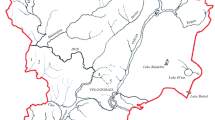Abstract
The ecological state of agricultural landscapes in the zone of insufficient moisture and modern approaches to their preservation and improvement on the example of the Volgograd region are outlined. The potential agricultural resources of the region and the state and level of production of the agricultural sector at the moment are presented. Methodological approaches to the performance of economic activities based on the principles of adaptive landscape agriculture are presented on a scientific basis. The typing of arable land in the agrolandscapes of the Volgograd region has been carried out with consideration of the bioclimatic potential of land use territories. Particular importance is attached to the distribution of arable land along the slopes, since the role of the relief in yield variation is very large, 40–70%; depending on the erosion of the soil, the yield can decrease by 10–80%. There is some correlation between the grain yield and soil properties. In particular, improvement of the nutritional regime and an increase in soil cultivation help reduce the negative impact of drought on the productivity of grain crops. The Federal Scientific Center of Agroecology of the Russian Academy of Sciences has developed a method to differentiate arable land according to the intensity of use; the provision of the arable layer with general humus is taken as the main criterion for the level of soil fertility. Four gradations are distinguished: cultivated, optimal, near-critical and critical. Ultimately, the development of adaptive landscape approaches is confirmed by the results of practical farming.
Similar content being viewed by others
REFERENCES
Agroekologicheskaya otsenka zemel’, proektirovanie adaptivno-landshaftnykh sistem zemledeliya i agrotekhnologii: Metodicheskoe rukovodstvo (Agroecological Assessment of Lands, Planning of Adaptive-Landscape Systems of Land Farming and Agrotechnologies: A Guide), Kiryushin, V.I. and Ivanov, A.L., Eds., Moscow: Rosinformagrotekh, 2005.
Agrolesomelioratsiya (Agroforestry), Ivanov, A.L. and Kulik, K.N., Eds., Volgograd: Vseross. Nauchno-Issled. Inst. Agrolesomelior., 2006.
Aidarov, I.P., Obustroistvo agrolandshaftov Rossii (Arrangement of Agricultural Landscapes in Russia), Moscow: Mosk. Gos. Univ. Pechati, 2007.
Bannikov, A.G., Vakulin, A.A., and Rustamov, A.K., Osnovy ekologii i okhrana okruzhayushchei sredy (Fundamentals of Ecology and Protection of Environment), Moscow: Kolos, 1999, 4th ed.
Baraev, A.I., Pochvozashchitnoe zemledelie: izbrannye trudy (k 90-letiyu A.I. Baraeva) (Soil Protective Land Agriculture: Selected Research Works (To the 90th Anniversary of A.I. Baraev)), Novosibirsk, 1998.
Dore, T., Makowski, D., Malézieux, E., Munier-Jolain, N., Tchamitchian, M., and Tittonell, P., Facing up to the paradigm of ecological intensification in agronomy: revisiting methods, concepts and knowledge, Eur. J. Agron., 2011, vol. 34, pp. 197–210.
Fokin, A.D., Resistance of soils and terrestrial ecosystems: approaches to the systemic definitions and assessment, Izv. Timiryazevsk. S-kh. Akad., 1995, no. 2, pp. 71–85.
Gostev, A.V., Pykhtin, I.G., Nitchenko, L.B., Plotnikov, V.A., and Pykhtin, A.I., The assessment system of the ecological balance of the agricultural landscape and the degree of compliance with the used farming system, Zemledelie, 2017, no. 8, pp. 3–6.
Grodzinskii, M.D., Assessment of resistance of geosystems to anthropogenic impacts, Fiz. Geogr. Geomorfol., 1986, no. 33, pp. 32–38.
Isachenko, A.G., Landshaftovedenie i fiziko-geograficheskoe raionirovanie: Uchebnik dlya vuzov (Landscape Science and Physical-Geographic Zonation: Manual for Higher Education Institutions), Moscow: Vysshaya Shkola, 1991.
Kashtanov, A.N., Lisetskii, F.N., and Shvebs, G.I., Osnovy landshaftno-ekologicheskogo zemledeliya (Principles of Landscape-Ecological Land Farming), Moscow: Kolos, 1994
Kiryushin, V.I., Ekologicheskie osnovy zemledeliya (Ecological Principles of Land Agriuclture), Moscow: Kolos, 1996.
Kiryushin, V.I., Teoriya adaptivno-landshaftnogo zemledeliya i proektirovaniya agrolandshaftov (Theory of Adaptive-Landscape Land Farming and Planning of Agrolandscapes), Moscow: Kolos, 2010.
Kiryushin, V.I., Ekologicheskie osnovy proektirovnaiya sel’skokhozyaistvennykh landshaftov: uchebnik (Ecological Principles of Planning of Agricultural Landscapes: Manual), St. Petersburg: Kvadro, 2018.
Lopyrev, M.I., Ustroistvo agrolandshaftov dlya ustoichivogo zemledeliya: uchebno-metodicheskoe posobie (Planning of Agrolandscapes for Sustainable Land Farming: Manual), Voronezh: Voronezh. Gos. Agrar. Univ., 2012.
Malezieux, E., Designing cropping systems from nature, Agron. Sustainable Dev., 2012, vol. 32, no. 1, pp. 15–29.
Masyutenko, N.P., Shekhovtsova, V.V., Shekhovtsov, A.I., and Leont’eva, E.V., Nauchnye osnovy i metody otsenki energeticheskogo sostoyaniya pochv v agrolandshaftakh (Scientific Principles and Assessment Methods of Energetic State of Soils in Agrolandscapes), Kursk: Vseross. Nauchno-Issled. Inst. Zempled. Zashch. Pochv Erozii, Ross. Akad. S-kh. Nauk, 2004.
Masyutenko, N.P., Chuyan, N.A., Bakhirev, G.I., Kuznetsov, A.V., Breskina, G.M., Dubovik, E.V., Masyutenko, M.N., Pankova, T.I., and Kaluzhskii, A.G., Sistema otsenki ustoichivosti agrolandshaftov dlya formirovaniya ekologicheski sbalansirovannykh agrolandshaftov (Assessment System of Resistance of Agrolandscapes for Planning of Ecologically Balanced Agrolandscapes), Kursk: Vseross. Nauchno-Issled. Inst. Zempled. Zashch. Pochv Erozii, Ross. Akad. S-kh. Nauk, 2013.
Metodika sistemnykh issledovanii lesoagrarnykh landshaftov (A Method of system Studies of Forest Agrarian Landscapes), Moscow: Vses. Akad. S-kh. Nauk im. V.I. Lenina, 1985.
Odum, E.P., Fundamentals of Ecology, Philadelphia: W.B. Saunders, 1971, 3rd ed.
Reimers, N.F., Prirodopol’zovanie. Slovar’-spravochnik (Nature Management: Dictionary-Handbook), Moscow: Mysl’, 1990.
Sukhov, A.N., Balashov, V.V., Filin, V.P., Moskvichev, A.Yu., Zelenev, A.V., and Levkin, V.N., Sistema zemledeliya Nizhnego Povolzh’ya: Uchebnoe posobie (Land Farming Systems of Lower Volga Region: Manual), Volgograd: Volgogr. Gos. S-kh. Akad., Niva, 2007.
Volodin, V.M., Eremina, R.F., and Mikhailova, N.F., Metodika opredeleniya ekologicheskoi emkosti i bioenergeticheskogo potentsiala territorii agrolandshafta (Determination of Ecological Volume and Bioenergetic Potential of the Agrolandscape Territory), Kursk: YuMEK, 2000.
Yuferev, V.G., Kulik, K.N., Rulev, A.S., Mushaeva, K.B., and Koshelev, A.V., Geoinformatsionnye tekhnologii v agrolesomelioratsii (GIS Technologies in Agroforestry), Volgograd: Vseross. Nauchno-Issled. Inst. Agrolesomelior., 2010.
Zhuchenko, A.A., Adaptive land farming, in Osnovy sistem zemledeliya Stavropol’ya (The Land Farming system of Stavropol Region), Penchukov, V.M. and Drozhko, G.R., Eds., Stavropol, 2005, pp. 73–113.
Author information
Authors and Affiliations
Corresponding author
Ethics declarations
Conflict of interests. The authors declare that they have no conflicts of interest.
Statement on the welfare of humans or animals. This article does not contain any studies involving animals performed by any of the authors.
Rights and permissions
About this article
Cite this article
Belyakov, A.M. Typing of Agricultural Landscapes in the Volgograd Region. Arid Ecosyst 11, 102–108 (2021). https://doi.org/10.1134/S2079096121010030
Received:
Revised:
Accepted:
Published:
Issue Date:
DOI: https://doi.org/10.1134/S2079096121010030



